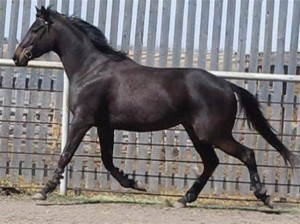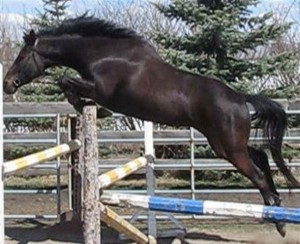The road trip – all 8,000 miles or 13,000 kilometers of it – was educational, but it took some sorting and thinking to clarify the observations and identify the potential lessons.
The first stop was Scottsdale (AZ) and a Saddlebred show at Westworld, where my intention was to attend the line classes to take pictures of a variety of Saddlebreds and Friesians. Unfortunately most of the halter classes were either cancelled or only had one entrant. Not enough for an educational sample. The lack of entrants made me wonder how healthy that aspect of the industry is, and it saddened me.
The next stop was Arcadia (CA) where I stayed at the home of sculptor, Jude Ettensperger (equiarts.com). Thanks, Jude! From that base I covered the Breeders’ Cup races, including several days of attending early morning works at Santa Anita prior to the big races on November 1st and 2nd.
Those early morning works allowed me to not only see most of the Breeders’ Cup horses, but also some of the entrants in the Arabian horse stakes race as well as the general equine population at Santa Anita. What struck me almost immediately was the high percentage of horses with short femurs. Interestingly, hardly any of the Breeders’ Cup horses – save a few two-year-olds – and none of the Arabians I saw had short femurs. Since the short-femur construction shortens the stride (more suitable for sprinting) and leads to injuries to the hind leg, especially from hock down, I wondered about a few things.
I wondered how much of the criticism of the track surfaces at Santa Anita was actually due to the surface and how much was due to the construction of the horses. When UC Davis was conducting their studies on hind leg injuries, I wished they had been open to examining conformational aspects. I knew that would not likely happen as when that venerable institute conducted their study on toe grabs, they did not include any aspects of conformation whatsoever. Wouldn’t it be handy to have a study showing whether certain conformational aspects put a horse at higher risk for particular injuries?
While listening to two media-accredited handicappers discuss the track and its speed bias – speed carries and no one closes – it struck me that in the previous stakes-level sprint races that they were discussing had not contained a single horse without a short femur. My thought: of course there would not be any closers if the entire field had short femurs. In a subsequent stakes race I spotted two horses in the field that did not have short femurs and they closed to finish in the top three. If there truly is a speed bias on the track, good horses built to close can overcome that bias…or maybe there isn’t really a speed bias. It dawned on me that it is likely human nature, and certainly to be expected in the horse industry, to gravitate to one answer and ignore other possibilities. That includes scientists, and I will write about that in a future post.
I also wondered why the short-femur construction was becoming so prevalent. I hypothesized that it may be in part due to an optical illusion, since that configuration gives the impression of a powerful (muscular) hindquarter even if it is not mechanically efficient. That made me wonder if that was a bias that came with some of the big-name trainers who originated in the Quarter Horse ranks. And once again I was saddened by what that trend means to racing and the horse industry in general…and it filled me with dread about what a trend towards short femurs means to horses…and not just racehorses.
The next stop was in southern Texas, where I looked at a small herd of Arabians that the owner hopes to use as a foundation for breeding breed-specific sport horses. Unfortunately I was not full of encouragement, but that is one of the hard parts of what I do. If I say what the person wants to hear, the horses and the industry suffer, so I have to explain what I see even if that means disappointing the person.
From there I went to northeastern Texas to look at a competition horse that is just coming back from an injury. To my eye, the injury was related to the horse’s construction and therefore predictable. It also meant that his previous level of competition was beyond his physical comfort zone and that any dreams of having him move up in levels would be detrimental to the horse. But is that how most people think? I suspect not.
A planned visit to see a client’s barrel race horse did not pan out, so I was off to Lexington (KY) for three different events.
The first event was the US Dressage Finals where I planned on taking halt pictures for conformational analysis of horses of various breeds and at various levels of competition. Unfortunately, despite media accreditation, the allotted photo spots were not conducive to that objective. The warm-up area also did not work and the wind was howling outside.
Next on the agenda was day two of the USEF Young Horse Championship Symposium. There were presentations from the three Olympic disciplines (Dressage, Eventing and Jumping) as well as Driving and Hunters. The agenda stated that these presentations would “consist of details regarding concepts, scoring, judging, etc.”
I put considerable thought into what was observed and stated. As a result, I have done further investigation into the success rates of young horse programs in general and will be writing an article encompassing those results for Warmbloods Today.
And finally, I attended portions of the Keeneland Mixed Sale and met with a couple of clients – one from Canada and one from Australia. The sale itself allowed the opportunity to view and photograph several horses, but, due to an increase in prices, not the opportunity to purchase. As usual, it surprises me how horses, particularly Thoroughbreds at a sale are promoted and purchased based on the pedigree page and not by the individual’s functional characteristics. What saddens me about that is the fact that young horses will be pushed to live up to the human expectations that result from marketing.
The most rewarding part of the whole trip was the affirmations of my work from the clients at the sale. The Canadian client related that the horse I helped him select had been sold to Australia as a broodmare after being Champion Two-Year-old Filly and Champion Three-year-old Filly in a regional market. Not bad for a $1700 purchase. The Australian client told me that I had been accurate (as with the filly mentioned above) about the colt’s preferred distance and style of running. He further said that, after he changed trainers to one that followed my advice, the horse made good money before a brain aneurism ended his career.
In the final analysis, I decided that if just one horse has a better life because of my work, I can’t complain…even if I wish I had more influence for the horses’ sakes.


